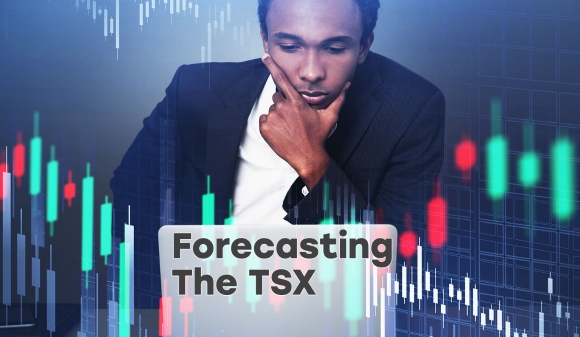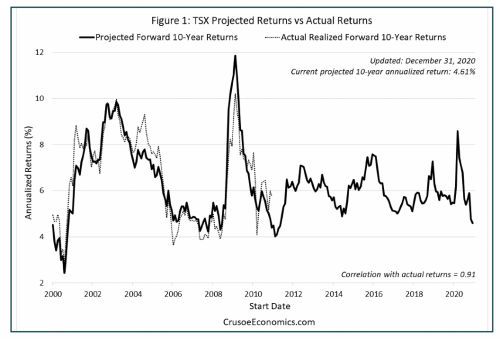Forecasting The TSX

 When it comes to framing our expectations of future stock market returns, most investors are all-too familiar with the common industry refrain “past performance is no guarantee of future returns”. Unfortunately, despite this oft-repeated warning, scores of investors today continue to assume that future equity market returns are largely predicted by the returns of the past. To some extent this makes sense, of course, as many of the fundamental drivers of stock market returns are reasonably likely to persist well into the future. Yet the fact that stocks may have historically delivered close to 10% per year in the long-run is hardly an iron-clad guarantee that investors deploying capital today will reap those same returns on a forward-going basis.
When it comes to framing our expectations of future stock market returns, most investors are all-too familiar with the common industry refrain “past performance is no guarantee of future returns”. Unfortunately, despite this oft-repeated warning, scores of investors today continue to assume that future equity market returns are largely predicted by the returns of the past. To some extent this makes sense, of course, as many of the fundamental drivers of stock market returns are reasonably likely to persist well into the future. Yet the fact that stocks may have historically delivered close to 10% per year in the long-run is hardly an iron-clad guarantee that investors deploying capital today will reap those same returns on a forward-going basis.
An investor who purchases equities at the peak of a once-in-a-lifetime stock market bubble, for example, is hardly in a position to realistically expect the “average” market return over the course of the next decade or so. Conversely, investors who acquire stocks immediately following a long and protracted market downturn have historically received above average market returns through the simple act of buying stocks “on sale”. While it is true that we can never say with certainty what the future holds for investors, it turns out that good financial theory allows us to make reasonably grounded projections of future stock market returns that are far more reliable than simply extrapolating historical equity returns forward in perpetuity.
Of course, trying to predict stock market performance over the very short term is a next-to-impossible task, with day-to-day market gyrations being largely the domain of day-traders, sentiment-driven speculators, and high-frequency-trading computer algorithms. Over longer periods of time, however, this task becomes infinitely easier, with market fundamentals coming to dominate speculative factors over periods of a decade or more. Using well-established forecasting methods that are highly correlated with actual realized stock market returns, this article outlines an equity forecasting model for the TSX total return index. It predicts returns for all rolling 10-year periods from 2000 to 2020 and tests these projections against the historical record for validity.
The results of this model are visualized in Figure 1, which shows a 10-year forecast of future stock market returns for every month beginning in January 2000. For example, the lowest return forecast shown in the chart (August 2000) projects a 10-year stock market total return of just 2.43% annualized. This means that an investor purchasing equities in August 2000 at the peak of the dot-com bubble could reasonably expect to receive 2.43% per year for the next 10 years, including dividends. Of course, since the above forecast does not account for inflation, fees, or taxes, investors purchasing stocks at the top of the dot-com bubble should have actually expected a near-zero total real return over the coming decade. This is a far cry from the 10% “average” stock market returns that many investors have come to expect based simply on a cursory look at the historical record.

Making predictions is one thing, of course, but how exactly did our model fare against actual realized returns? As it turns out, quite well. Annualized 10-year total returns actually delivered by the TSX from August 2000 to 2010 came in at 2.84%, versus the projected return of 2.43% predicted by our forecasting model. Indeed, Figure 1 overlays all available historical 10-year market returns against projected returns from the model, illustrating a high correlation between our equity forecasts and actual realized returns. In terms of measuring the strength of this correlation, the “correlation coefficient” turns out to be a respectable 0.91, which is fairly close to a perfect correlation of one.
The reader will no doubt be wondering exactly how these projections of future stock market returns were derived. The answer is that they are based on simple projections of dividends and capital appreciation which, at the most basic level, are where all returns come from. The late investor John Bogle had a simple way of explaining the source of long-term equity returns, pointing out that stocks are ultimately comprised of two types of returns - a “fundamental return” and a “speculative return”. The fundamental return is the return to shareholders based on underlying business conditions such as cash-flows and profitability, while the speculative return is based simply on what investors are willing to pay for these cash-flows and earnings at any given point in time. Estimates of the fundamental return over a sufficiently long period of time should therefore be adjusted by an estimate of the speculative return to arrive at a reasonable forecast of the total return.
The first component of the fundamental return is the actual cash paid by the stock market to investors in the form of dividends. Over a period of 10 years, we can estimate the dividend yield an investor is likely to receive by looking first at the current yield of the stock market. We then assume that over the coming decade the current dividend yield will mean-revert to its long-run average, delivering a yield to investors somewhere between the current yield and average yield. The model’s most recent forecast, for example, takes the dividend yield of 3.03% at the end of December and assumes it will revert to its long-term average of 3.03% over the following decade. Our estimate of the fundamental return originating from dividends is therefore (3.03+2.3)/2 = 2.67%.
The second component of the fundamental return is capital appreciation due to corporate profitability. Over time, as the economy grows, corporate profits increase, and with it the prices of publicly traded shares. In other words, if we are to predict capital appreciation of the stock market due to fundamentals, it is necessary to first estimate the growth of corporate profits over the coming decade. For this we use a method popularized by Warren Buffett, who recognized that in the long run corporate profits tend to grow in line with the economy. This insight allows us to estimate the rate of growth of the stock market by simply estimating nominal GDP growth. In a similar manner to how we estimate the 10-year dividend yield, the model takes recent GDP growth of 2.10% and assumes it will mean-revert to its long-term average of 4.37% over the coming decade. This gives us an estimate of the fundamental return due to capital appreciation of (2.10+4.37)/2 = 3.24%.
The fact that the stock market tends to grow at the rate of nominal GDP suggests that the stock market should tend to remain fairly proportional in size to the overall economy. While the value of the stock market may indeed ebb and flow from day-to-day due entirely to speculative factors, in the long run it tends to remain relatively constant at roughly 115% the size of the economy. Or said another way, when dividing the value of the stock market by nominal GDP, this ratio has historically hovered around 115 over long periods of time, regardless of where speculators push prices in the short term. If the economy grows by five per cent and the stock market grows by 10% in the short-run, for example, then the size of the stock market relative to GDP will grow higher than its historical ratio of 115. In this scenario, investors are clearly willing to pay more for a dollar of earnings than they were previously, a phenomenon that has generally tended to be temporary over time.
In order to calculate the speculative return, our forecasting model therefore assumes that the current stock market-to-GDP ratio will revert from its current value to 115 over a 10-year period. If the ratio is currently below 115, this results in a positive speculative return, as stock prices must grow faster than the economy to re-attain this historical ratio. Conversely, if the ratio is currently above 115, this results in a negative speculative return since stock prices must appreciate at a slower pace than GDP to fall back to a ratio of 115. At the end of December, the stock market-to-GDP ratio stood at approximately 131, implying that equities were overvalued on a historical basis. In order for this ratio to fall from 131 to 115 over a 10-year period, the speculative return calculated by our model works out to roughly -1.30% per year, or approximately -12% in total.
By subtracting this 1.30% speculative return from the previously calculated fundamental return of 2.67% due to dividends and 3.24% due to economic growth, our December 2020 forecast for 10-year future returns comes to 4.61%. Indeed, this is the same methodology used to calculate all 10-year return projections shown in Figure 1, which, as previously stated, collectively exhibits a relatively high 0.91 correlation with actual realized returns. A compound annual growth rate of 4.61% is hardly a guarantee, of course, but it remains a far more reliable estimate than simply assuming that historical returns will continue in perpetuity.
At the end of the day, however, equity forecasts are merely best-guesses of future trends. While the results shown in Figure 1 tend to track actual returns rather closely, there are a multitude of risks that could easily cause projected returns to veer sharply from actual returns at some point in the future. Chief among these risks is the very real possibility that speculative sentiment may not actually be mean-reverting over the 10-year forecasting period. Markets can remain irrational for long periods of time, and there is nothing to say that the stock-market-to-GDP ratio cannot remain either substantially above or below 115 for periods longer than 10 years. Sentiment is extremely volatile, and it may indeed be the case that future valuations simply diverge from the historical average on a long-term basis. While unlikely, this would undoubtedly cause the “speculative return” component of our forecasting model to fall well off the mark.
The fundamental return too may be subject to long-term or permanent shifts relative to what has historically been considered “average”. For example, corporate policies regarding dividend payouts may diverge from long-term averages as companies choose to retain a greater or lesser proportion of their earnings in response to available investment opportunities. Alternatively, structural changes in the economy might well lead to prolonged periods of either above average or below average growth over the 10-year forecasting period. This would invariably lead to our estimates for stock market capital appreciation due to GDP growth deviating considerably as a result of long-term changes in either per-capita productivity or immigration.
Despite these uncertainties, however, simple forecasting models that are reasonably correlated with actual market returns provide a powerful tool for investors looking to anchor their expectations of future performance. It is true that such models will hardly tell you what the stock market is likely to do over the coming days or weeks, but having reasonable return assumptions over the following decade is arguably far more useful for long-term retirement planning than trying to trade in and out of stocks on a short-term basis. Our current forecast of 4.61% per year over the next decade, for example, says almost nothing about what tomorrow will bring. It does, however, imply that forward 10-year equity returns are unlikely to be outrageously high, which should give pause to those investors with overly optimistic long-term retirement assumptions.
Many investors tend to look at equity exposure in a binary light, meaning that they are either heavily exposed to equity risk as “bulls”, or out of the market entirely as “bears”. One of the primary benefits of looking at forecasting models such as the one shown in Figure 1 is that these models aren’t designed to provide investors with discrete “buy” and “sell” signals. They merely provide probabilistic outcomes across the equity return spectrum, providing a framework for investors to allocate capital as they deem fit. While equity returns of 4.61% per year over the coming decade may not exactly be shooting out the lights, in the current low interest rate environment characterized by negative real returns from riskless assets, for the majority of investors, historically below-average returns might just well be enough.
Brian Chang is the author of the finance blog Crusoe Economics (https://crusoeeconomics.com). He resides in Vancouver and can be contacted by email at info@crusoeeconomics.com or on twitter @CrusoeEconomics.


